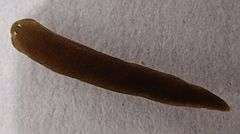Schmidtea polychroa
| Schmidtea polychroa | |
|---|---|
 | |
| Living specimen of S. polyhcroa | |
| Scientific classification | |
| Kingdom: | Animalia |
| Phylum: | Platyhelminthes |
| Class: | Turbellaria |
| Order: | Tricladida |
| Suborder: | Continenticola |
| Family: | Dugesiidae |
| Genus: | Schmidtea |
| Species: | S. polychroa |
| Binomial name | |
| Schmidtea polychroa (Schmidt, 1861) | |
| Synonyms | |
| |
Schmidtea polychroa is a species of freshwater flatworm, a dugesiid triclad that inhabits the shallow mesotrophic or eutrophic waters of rivers and lakes of Europe. It is also present in North America, where it has been introduced at least in the Saint Lawrence river system.[1][2] It is an animal with a limited dispersion capability.[3]
Diet
Individuals of this species search for food actively; they feed mainly on small invertebrates.[4] They prey preferably on oligochaetes, and also on gastropods.[1]
Reproduction
They are hermaphroditic. Schmidtea polychroa produces cocoons in water temperatures between 10 and 23 °C.[5]
References
- 1 2 Boddington, M. J.; Mettrick, D. F. (1974). "The distribution, abundance, feeding habits, and population biology of the immigrant triclad Dugesia polychroa (Platyhelminthes: Turbellaria) in Toronto Harbour, Canada". Journal of Animal Ecology. 43 (3): 681–699. doi:10.2307/3531.
- ↑ Kenk, R. (1989). Revised list of the North American freshwater Planarians (Platyhelminthes. Smithsonian Contributions to Zoology 476, 1-10.
- ↑ Pongratz, N.; Gerace, L.; Michiels, N. K. (2002). "Genetic differentiation within and between populations of a hermaphroditic freshwater planarian". Heredity. 89 (1): 64–69. doi:10.1038/sj.hdy.6800102. PMID 12080371.
- ↑ Calow, P.; Davidson, A. F.; Woollhead, A. S. (1981). "Life-cycle and feeding strategies of freshwater triclads: A synthesis". Journal of Zoology. 193 (2): 215–237. doi:10.1111/j.1469-7998.1981.tb03441.x.
- ↑ Reynoldson, T. B.; Young, J. O.; Taylor, M. C. (1965). "The Effect of Temperature on the Life-Cycle of Four Species of Lake-Dwelling Triclads". Journal of Animal Ecology. 34 (1): 23–43. doi:10.2307/2367.
This article is issued from Wikipedia - version of the 9/2/2015. The text is available under the Creative Commons Attribution/Share Alike but additional terms may apply for the media files.